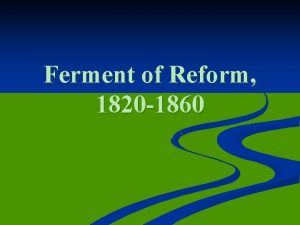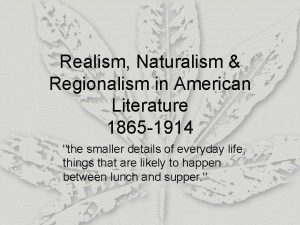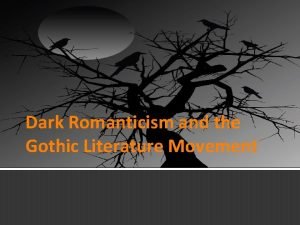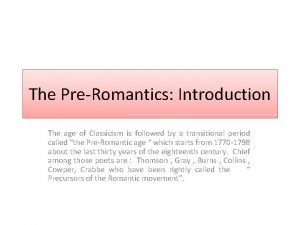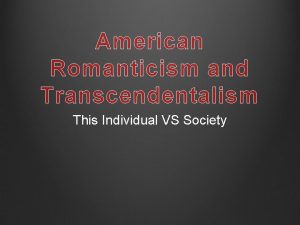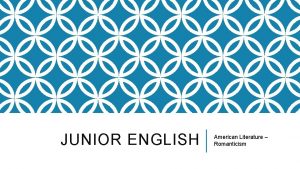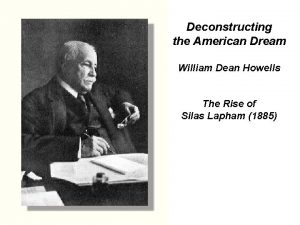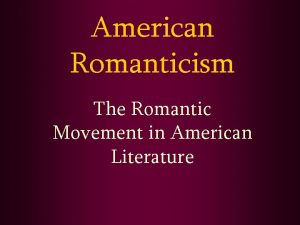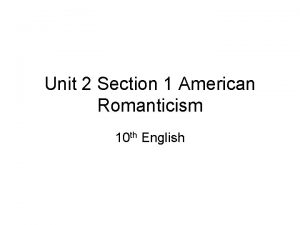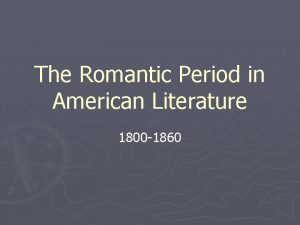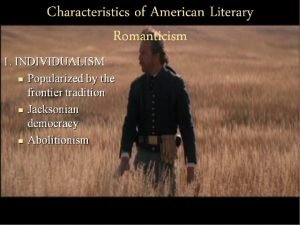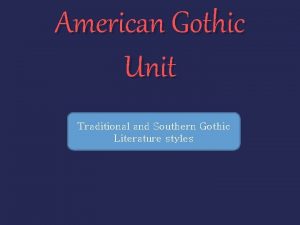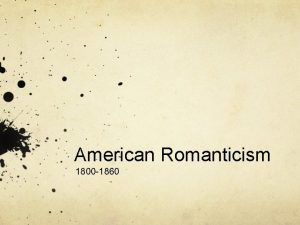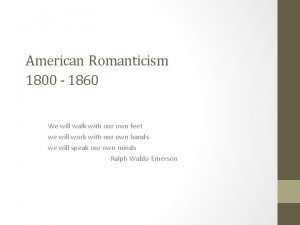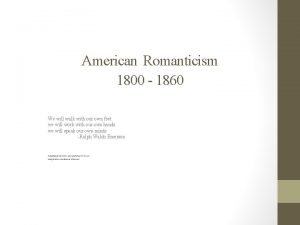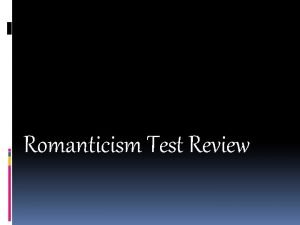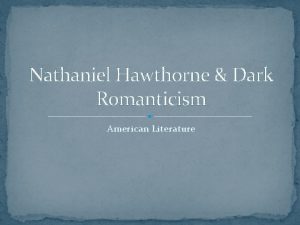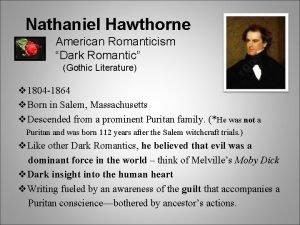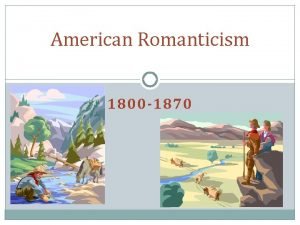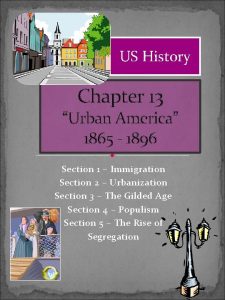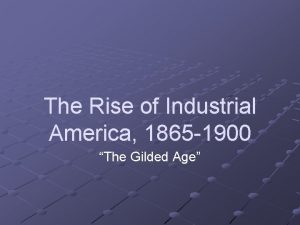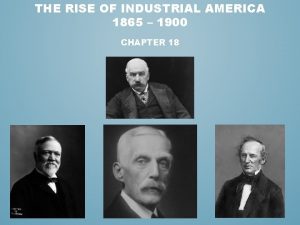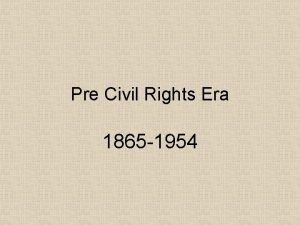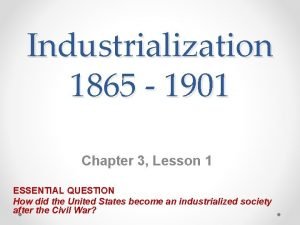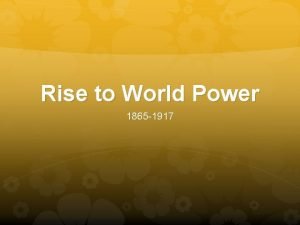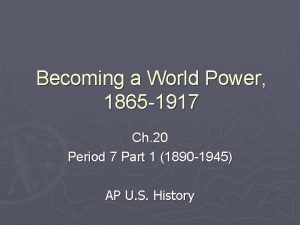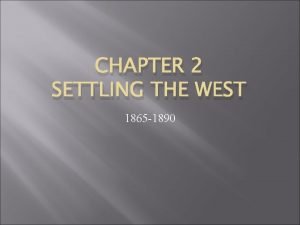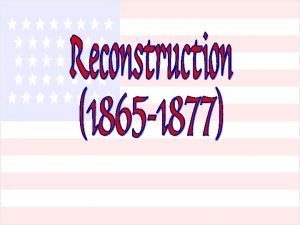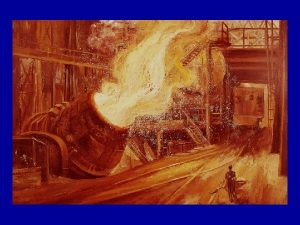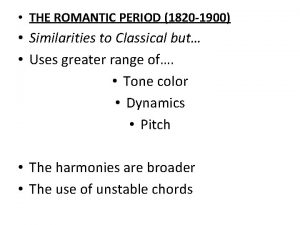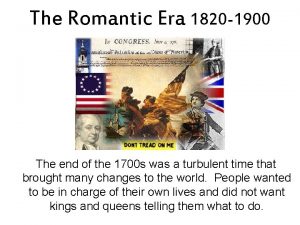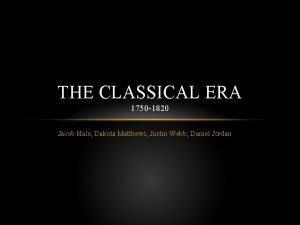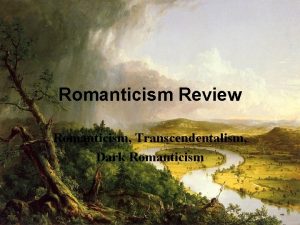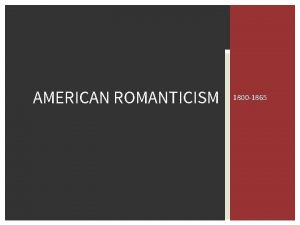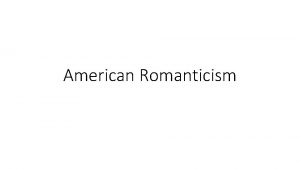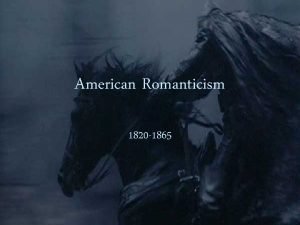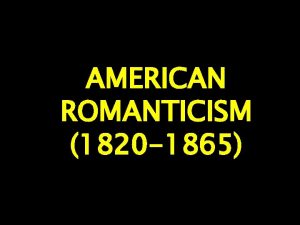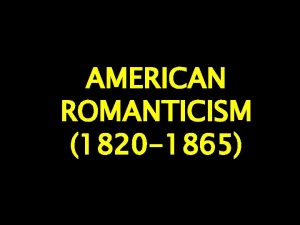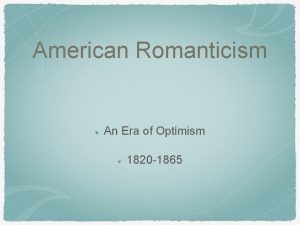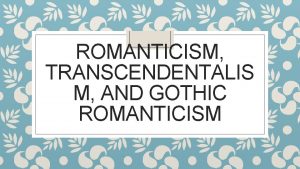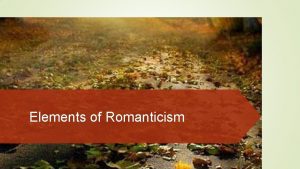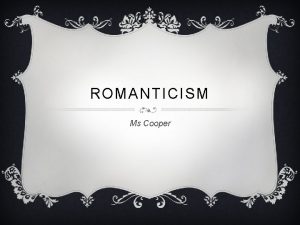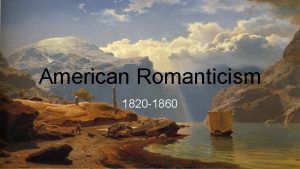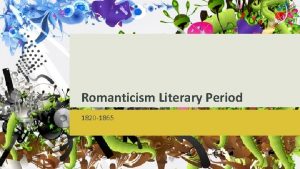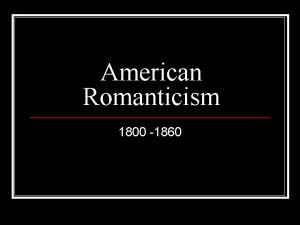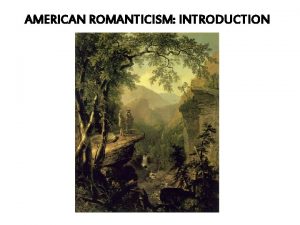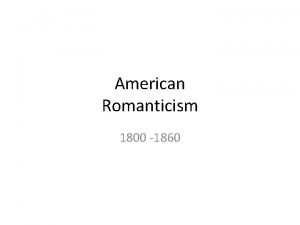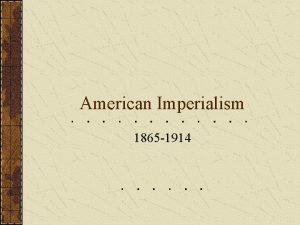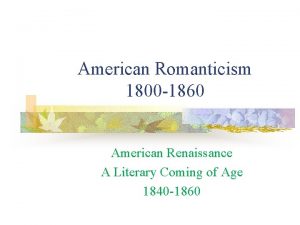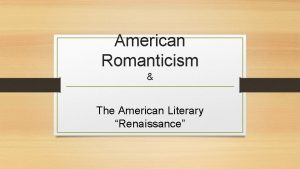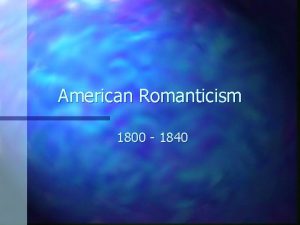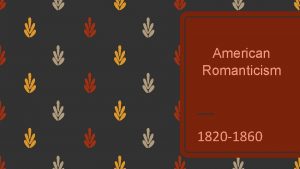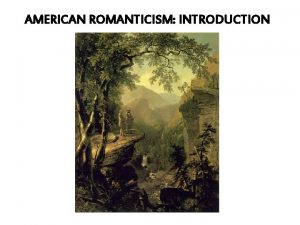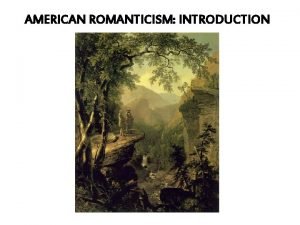Romanticism and the American Renaissance 1820 1865 1









































- Slides: 41

Romanticism and the American Renaissance (1820 – 1865) 1. DEVELOPMENT OF AMERICAN ROMANTIC LITERATURE IN THE 19 TH CENTURY. 2. THE MONROE DOCTRINE. 3. THE AMERICAN RENAISSANCE OF 1836 – 1865. ABOLITIONISM. 4. AMERICAN ROMANCE AND POETRY.

1. Development of American romantic literature in the 19 th century.

American and European Romanticisms are connected in: �Search for truth, �Development of a harmonious personality, �Celebration of beauty, �Description of life as a struggle between vice and virtue, �Romanticists believed that emotions shape people's experience and their knowledge of the world.

Distinctive features of American Romanticism: �The Romantic Movement was the first major literary movement in a very young America; �The first foundations of American national literature were laid; �the American Romantics celebrate the beauty of American landscape; �It was also a new attitude toward people, promoting the individual, standing against society; �The American Romantics liked to experiment with form and the novel became an important vehicle for expression (unlike the European Romantics who focused mainly on poetry).

New themes and challenges of American Romanticism: �an impulse toward reform (women's rights, abolition of slavery); �a concern with the impact of new technology; �an idealization of women (Edgar Allan Poe's Anabel Lee, for example); �a fascination with death and the supernatural (Nathaniel Hawthorne, Edgar Allan Poe); �the expanding population due to immigration; �the role of government; �The geographical expansion; �the treatment of Native Americans.

Specific genres of American Romanticism: �Captivity narratives (for ex. , “A narrative of the Captivity and Restoration of Mrs. Mary Rowlandson”); �Narratives about Native Americans (for ex. , “The American Savage: how he may be tamed by the weapons of civilization”); v Tall tale, tale narrative that depicts the wild adventures of extravagantly exaggerated folk heroes; v Local color or regional literature is fiction and poetry that focuses on the characters, dialect, customs, topography, and other features particular to a specific region.

Traditional genres, developed by American Romanticism: �the novel (historical, social, fantastic), �the romance, �the short story, �ballads, �epics, �folk-tales of the Indians.

The North American Review �North American Review (NAR) was the first literary magazine in the United States. It was founded in Boston in 1815 by journalist Nathan Hale and others. �It called for American writers to stop imitating British and continental stereotypes. �It printed only American material.

The publications of American writers (by the end of the 1820 s ): Washington Irving “Sketch Book” (1819) William Cullen Bryant “Poems” (1821) Noah Webster “American Dictionary” (1828) James Fenimore Cooper “Leatherstocking Tales” (1823) Edgar Allan Poe “Poems “ (1827)

The Knickerbocker school � The group of writers active in and around New York City during the first half of the 19 th century. Its most prominent members included Washington Irving, James Fenimore Cooper and William Cullen Bryant Each were respectively pioneers in general literature; novels, poetry and journalism. Taking its name from Washington Irving’s Knickerbocker’s History of New York (1809), the group sought to promote a genuinely American national culture and establish New York City as its literary centre. � Other writers associated with the group were the abolitionist and woman-suffrage crusader Lydia M. Child, editor and politician G. C. Verplanck, Clement Moore, scholar and author of “’Twas the Night Before Christmas” (1823), and the poet and travel writer Bayard Taylor. � The Knickerbocker Magazine (1833– 65), a literary monthly edited by Lewis G. and Willis G. Clark, though not an official organ of the group, published members’ work.

The Bread and Cheese Club � Bread and Cheese Club, also called the Lunch and the Lunch Club, social and cultural conclave created by author James Fenimore Cooper, which held meetings at Washington Hall, on the southeast corner of Broadway and Reade streets in New York City, from its formal beginning in 1824 until at least 1827. Its membership consisted of American writers, editors, and artists, as well as scholars, educators, etc.

The Saturday Club � The Saturday Club, established in 1855, was an informal monthly gathering in Boston, Massachusetts, of writers, scientists, philosophers, historians and other notable thinkers of the midnineteenth century. � The original members of the group included Horatio Woodman, Louis Agassiz, Richard Henry Dana Jr. and James Russell Lowell. In the following years membership was extended to Oliver Wendell Holmes, Cornelius Conway Felton, Henry Wadsworth Longfellow, William Hickling Prescott. Other members included Ralph Waldo Emerson, Asa Gray, John Lothrop Motley, Benjamin Peirce, Charles Sumner, John Greenleaf Whittier “A Group of the Saturday Club", from Life and others. and Letters of Oliver Wendell Holmes, 1896

The Authors Club �The Authors Club, an association for literary-minded gentlemen and a support group for younger writers, was formed in New York City in 1882. Boston Authors Club

Flourishing from 1820 to 1850, Romanticism can be divided into Early Romanticism (the twenties and thirties) and Late Romanticism (the forties and fifties). � The early period began with the romances and short stories of Washington Irving (1783— 1859). These forms were developed later by other American writers. The historical novel began in America with Fenimore Cooper (1789— 1851). Romantic poetry appeared in great variety; most outstanding were the poems of Edgar Allan Рое (1809 - 1849). � The Late Romanticism was the years of mature Romanticism in American literature. Characteristic of this period were Cooper's later novels, Edgar Allan Poe's romances and poems written during the last eight years of his life, the works of Henry Wadsworth Longfellow (1807 -1882), and the poems by Walt Whitman (1819 - 1892).

2. The Monroe doctrine. James Monroe was the fifth president of the United States from 1817 to 1825.

Monroe Doctrine � Monroe Doctrine, (December 2, 1823), cornerstone of U. S. foreign policy enunciated by Pres. James Monroe in his annual message to Congress. � Declaring that the Old World and New World had different systems and must remain distinct spheres, Monroe made four basic points: � (1) the United States would not interfere in the internal affairs of or the wars between European powers; � (2) the United States recognized and would not interfere with existing colonies and dependencies in the Western Hemisphere; � (3) the Western Hemisphere was closed to future colonization; � (4) any attempt by a European power to oppress or control any nation in the Western Hemisphere would be viewed as a hostile act against the United States.

3. The American Renaissance of 1836 – 1865. Abolitionism.

The Panic of 1837 �The Panic of 1837 was a major recession in the US economy that began in the spring of 1837 and lasted until the mid-1840 s.

American Civil War �American Civil War, also called War Between the States, four-year war (1861– 65) between the United States and 11 Southern states that seceded from the Union and formed the Confederate States of America.

Andrew Jackson � the seventh president of the United States from 1829 to 1837; � an idiomatic western genius; � The Papers of Andrew Jackson is a project to collect and publish Jackson's entire extant literary record. � The Andrew Jackson Papers is one of twenty-three presidential collections in the Manuscript Division of the Library of Congress. The Jackson archival collection contains more than 26, 000 items dating from 1767 to 1874, including memoranda, journals, speeches, military records, land deeds, and miscellaneous printed matter, as well as correspondence reflecting Jackson’s personal life and career as a politician, military officer, president, slave holder and property owner from 1785 to 1845). 1767 - 1845

Abraham Lincoln � The 16 th president of the United States (1861– 65) � The papers of Abraham Lincoln contain approximately 40, 550 documents dating from 1774 to 1948, although most of the collection spans from the 1850 s through Lincoln’s presidency (18611865) � the value of a “plain, native” style, used to characterize speech or writing that is simple, direct 1809 - 1865

Transcendentalism � Transcendentalism is a philosophical movement that developed in the late 1820 s and 1830 s in the eastern United States, based on a belief in the essential unity of all creation, the innate goodness of humanity, and the supremacy of insight over logic and experience for the revelation of the deepest truths. � It prepared the ground and introduced the American Renaissance in literature. Representatives: � Ralph Waldo Emerson, � Henry David Thoreau, � Margaret Fuller, � Orestes Brownson, � Elizabeth Palmer Peabody, � James Freeman Clarke, � George Ripley, � Bronson Alcott, � Walt Whitman, � Herman Melville, � Nathaniel Hawthorne.

American Renaissance or New England Renaissance �American Renaissance, also called New England Renaissance, period from the 1830 s roughly until the end of the American Civil War in which American literature, in the wake of the Romantic movement, came of age as an expression of a national spirit. �The literary scene of the period was dominated by a group of New England writers, the “Brahmins” : Henry Wadsworth Longfellow, Oliver Wendell Holmes and James Russell Lowell. �The Transcendentalists advocated reforms in church, state, and society, contributing to the rise of free religion and the abolition movement (for ex. : the poet John Greenleaf Whittier and the novelist Harriet Beecher Stowe “Uncle Tom’s Cabin”, 1852) and to the formation of various utopian communities such as “Brook Farm”.

The Abolition Movement �President Abraham Lincoln issued the Emancipation Proclamation on January 1, 1863 (the third year of Civil War). The proclamation declared "that all persons held as slaves" within the rebellious states "are, and henceforward shall be free“.

4. American romance and poetry.

American romance �This genre expresses the American romantic vision; �It is an emotional and symbolic form of a novel; �It is characterized by special techniques used to communicate complex meanings; �The form of an American romance is determined by the absence of traditional community life in America; �This genre is influenced by a history of revolution, wild geography, relatively classless democratic society.

American romance �Nathaniel Hawthorne ( 1806 – 1864) “The Scarlet Letter” �Herman Melville (1819 – 1891) “Moby Dick”

American romance � English novels showed poor main characters, rising to prosperity as a result of marriage or the discovery of a hidden aristocratic background. � Such plots didn’t challenge the social structure of English society. � American novelists couldn’t depend on some established tradition. � The main character could find himself alone among cannibal tribes (for ex. : “Typee”, 1846 by Herman Malville). � The tragic note in American literature became dominant in he novels, showing the greater social tragedy od a society at war with itself.

Washington Irving (1783 – 1859) This writer is called the “first American man of letters. ” He is best known for the short stories “The Legend of Sleepy Hollow” and “Rip Van Winkle. ” These tales have been called the first American short stories. They are both Americanized versions of German folktales. The main character of “Rip Van Winkle” is a henpecked husband who sleeps for 20 years and awakes as an old man to find his wife dead, his daughter happily married, and America now an independent country.

Rip Van Winkle by Washington Irving � Rip Van Winkle is a short story by Washington Irving, published in The Sketch Book in 1819– 20. It is set in the Dutch culture of pre-Revolutionary War New York state. � Rip Van Winkle is an amiable farmer who wanders into the Catskill Mountains, where he comes upon a group of dwarfs playing ninepins. Rip accepts their offer of a drink of liquor and promptly falls asleep. When he awakens, 20 years later, he is an old man with a long white beard; the dwarfs are nowhere in sight. When Rip returns to town, he finds that everything is changed: his wife is dead, his children are grown, and George Washington’s portrait hangs in place of King George III’s. The old man entertains the townspeople with tales of the old days and of his encounter with the little men in the mountains.

American Poetry �William Cullen Bryant (1794 – 1878), “an American Wordsworth”, Wordsworth an American romantic poet, journalist, and editor for 50 years of the New York Evening Post. As a man of letters, Bryant established himself with Poems (1821). Bryant will be remembered longest as the poet of his native Berkshire hills and streams in such poems as “Thanatopsis” and “To a Waterfowl. ”

American Poetry Ø Ø Ø The New England Brahmins (or The Boston Brahmins) Originally a reference to the Brahmans, the highest caste of Hindu society, the term came to be applied to a number of prominent New England writers, including Oliver Wendell Holmes, Henry Wadsworth Longfellow, Longfellow and James Russell Lowell All three were educated in Europe and became associated with Harvard University. They made Boston, Massachusetts, the literary capital of America in their day. Though they espoused democratic ideals, they remained aesthetically conservative. In an age that brought forth the masterpieces of Ralph Waldo Emerson, Henry David Thoreau, Nathaniel Hawthorne, Herman Melville, Walt Whitman, Edgar Allan Poe, and Mark Twain, they advocated a genteel, rational humanism. The Brahmins exerted the main influence on American literary taste until the 1890 s.

American Poetry � James Russell Lowell (1819 - 1891) � James Russell Lowell was an American poet, critic, essayist, editor, and diplomat whose major significance probably lies in the interest in literature he helped develop in the United States. � He wrote about 50 antislavery articles for periodicals (from 1845 to 1850); satirical verses “Biglow Papers” (1848) used a humorous and original New England dialect; The Vision of Sir Launfal (1848), an enormously popular long poem extolling the brotherhood of man; and A Fable for Critics (1848), a witty and rollicking verse evaluation of contemporary American authors.

American Poetry � Oliver Wendell Holmes (1809 – 1894) � Oliver Wendell Holmes was a member of the Fireside Poets (The terms “Fireside Poets” or “Schoolroom Poets” are used to designate a group of five poets— William Cullen Bryant, Henry Wadsworth Longfellow, John Greenleaf Whittier, Oliver Wendell Holmes, and James Russell Lowel). � Oliver Wendell Holmes was mainly known for his Harvard University lectures and book The Autocrat of the Breakfast Table (1858), in which some of his poems were featured. Holmes achieved his greatest fame as a humorist and poet. He wrote much poetry (for ex. : “Old Ironsides” (1830)

American Poetry � Henry Wadsworth Longfellow (1807 – 1882) � The most widely known and best- loved American poet of his lifetime, Henry Wadsworth Longfellow achieved a level of national and international prominence previously unequaled in the literary history of the United States. � Poems such as Paul Revere’s Ride (1863); Evangeline, A Tale of Acadie (1847); A Psalm of Life (from Voices of the Night, 1839); In 1884 he was honoured by the The Song of Hiawatha (1855) placing of a memorial bust in Poets’ became mainstays of national Corner of Westminster Abbey in London, the first American to be so culture. recognized.

American Poetry � John Greenleaf � American poet and abolitionist. Whittier (1807 – 1892) � His first volume of poems Legends of New England was published in 1831. � Famous with numerous volumes of verse: Lays of My Home (1843), Voices of Freedom (1846), Songs of Labor (1850), The Panorama (1856), Home Ballads and Poems (1860), The Tent on the Beach (1867), Among the Hills (1868), and The Pennsylvania Pilgrim (1872). � His best-known poem is “Maud Muller” (1854) with its lines “Of all sad words of tongue and pen/ The saddest are these, ‘It might have been. ’ ”

American Poetry �Edgar Allan Poe (1809 – 1849) is an American short-story writer, poet, critic, and editor who is famous for his cultivation of mystery. His tale “The Murders in the Rue Morgue” (1841) initiated the modern detective story, story and the atmosphere in his tales of horror is unrivaled in American fiction.

American Poetry �His poem “The Raven” (1845) numbers among the best-known poems in the national literature.

American Poetry �Walt Whitman (1819 – 1892) is an American poet, journalist, and essayist whose verse collection Leaves of Grass, first published in 1855, is a landmark in the history of American literature. �Under the influence of the Romantic movement in literature and art, Whitman held theory that the chief function of the poet was to express his own personality in his verse �In Leaves of Grass he addressed the citizens of the United States, urging them to be large and generous in spirit, a new race nurtured in political liberty, and possessed of united souls and bodies.

American Poetry �Emily Dickinson (1830 – 1886)�American lyric poet, he author of nearly 1, 800 poems. � With Walt Whitman, Dickinson is widely considered to be one of the two leading 19 th-century American poets. � She worked in verse forms suggestive of hymns and ballads, and freely ignored the usual rules of versification and even of grammar. � Dickinson's poetry was heavily influenced by the Metaphysical poets of seventeenth-century England.

American Poetry �Emily Dickinson most THE BRAIN IS WIDER THAN THE SKY often punctuated her poems with dashes. She also capitalized interior words, not just words at the beginning of a line. �Emily Dickinson used the dash to fragment language and to cause unrelated words to rush together. The Brain – is wider than the Sky – For – put them side by side – The one the other will contain With ease – and You – beside – The Brain is deeper than the sea – For – hold them – Blue to Blue – The one the other will absorb – As Sponges – Buckets – do – The Brain is just the weight of God – For – Heft them – Pound for Pound – And they will differ – if they do – As Syllable from Sound –
 American reform movements between 1820 and 1860
American reform movements between 1820 and 1860 Realism v naturalism
Realism v naturalism Gothic romanticism art
Gothic romanticism art Pre romantic poet
Pre romantic poet The romanticism (1795 — 1835) what is romanticism
The romanticism (1795 — 1835) what is romanticism Romanticism and transcendentalism
Romanticism and transcendentalism Enlightenment classicism romanticism renaissance timeline
Enlightenment classicism romanticism renaissance timeline Renaissance vs romanticism
Renaissance vs romanticism American romanticism characteristics
American romanticism characteristics American gothic romanticism
American gothic romanticism American romanticism authors
American romanticism authors Unit 2 lesson 10 american romanticism test
Unit 2 lesson 10 american romanticism test Romantic period american literature
Romantic period american literature Characteristic of american romanticism
Characteristic of american romanticism American gothic poem
American gothic poem American romantic period
American romantic period American romanticism 1800 to 1860 worksheet answers
American romanticism 1800 to 1860 worksheet answers Famous american poet
Famous american poet American romanticism 1800 to 1860 worksheet answers
American romanticism 1800 to 1860 worksheet answers Rationalism vs romanticism
Rationalism vs romanticism Romanticism test
Romanticism test Dark romanticism definition
Dark romanticism definition Dark romanticism in young goodman brown
Dark romanticism in young goodman brown American romanticism characteristics
American romanticism characteristics Urban america 1865 to 1896
Urban america 1865 to 1896 Hollywood silver fox farm v emmett
Hollywood silver fox farm v emmett The rise of industrial america 1865-1900
The rise of industrial america 1865-1900 Four features of industrial manufacturing (1865-1900)
Four features of industrial manufacturing (1865-1900) 1954-1865
1954-1865 Industrialization (1865 to 1901 worksheet answers key)
Industrialization (1865 to 1901 worksheet answers key) Becoming a world power 1865-1917
Becoming a world power 1865-1917 Impressionism characteristics
Impressionism characteristics Becoming a world power 1865-1917
Becoming a world power 1865-1917 Soddie
Soddie Al cruzar una planta de guisantes de flores purpura
Al cruzar una planta de guisantes de flores purpura How did the term impressionism originate
How did the term impressionism originate 1877-1865
1877-1865 Industrialization (1865 to 1901 worksheet answers key)
Industrialization (1865 to 1901 worksheet answers key) 1865 to 1900 inventions
1865 to 1900 inventions Characteristic of the romantic period
Characteristic of the romantic period 1820 hairstyles
1820 hairstyles It is an era from 1750-1820
It is an era from 1750-1820
